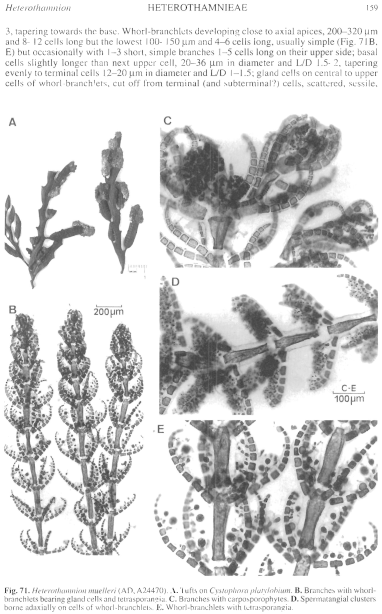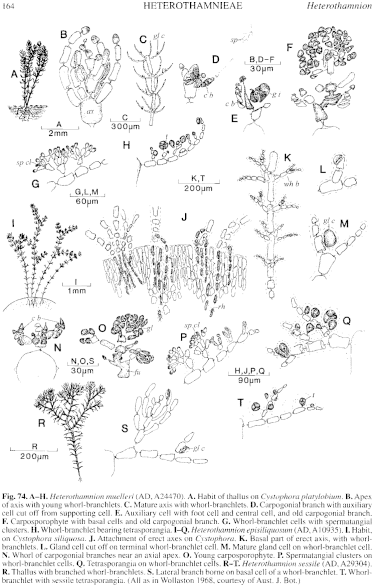|
|
|
|
|
|||||||||||
|
Electronic Flora of South Australia Species Fact Sheet
Phylum Rhodophyta – Order Ceramiales – Family Ceramiaceae – Tribe Heterothamnieae
Selected citations: Athanasiadis 1996: 185, fig. 94. Kylin 1956: 373. Wollaston 1968: 352, fig. 31A–O.
Synonym
Callithamnion muelleri Sonder 1853: 513; 1881: 10. J. Agardh 1876: 27. De Toni 1903: 1337. Harvey 1863, synop.: liv. Lucas 1909: 49. Lucas & Perrin 1947: 333. Tisdall 1898: 502. Wilson 1892: 187.
Thallus (Fig. 71A) in small, dense, tufts 3–5 mm high, with several clumped axes from the base (Fig. 74A) of penetrating rhizoids, each axial cell bearing (2–) 4 whorl-branchlets (Figs 71B, 74C) at right angles to the axis, usually unbranched and upwardly curved. Attachment by basal rhizoids (with branching from just under the host surface) penetrating the host; epiphytic on Cystophora platylobium. Structure. Apical cells 6–8 µm in diameter and L/D 1–1.5, enlarging rapidly (Fig. 74B) to axial cells 70–100 µm in diameter and L/D 2– 3, tapering towards the base. Whorl-branchlets developing close to axial apices, 200–320 µm and 8–12 cells long but the lowest 100–150 µm and 4–6 cells long, usually simple (Fig. 71B, E) but occasionally with 1–3 short, simple branches 1–5 cells long on their upper side; basal cells slightly longer than next upper cell, 20–36 µm in diameter and L/D 1.5–2, tapering evenly to terminal cells 12–20 µm in diameter and L/D 1–1.5; gland cells on central to upper cells of whorl-branchlets, cut off from terminal (and subterminal?) cells, scattered, sessile, ovoid, 12–25 µm in diameter, touching only the bearing cell. Lateral branches replacing a whorl-branchlet. Cells uninucleate; rhodoplasts discoid, some becoming elongate.
Reproduction: Gametophytes dioecious. Usually a single procarp is borne on the second or third axial cell at branch apices, the bearing cell being smaller than the cell below; whorl-branchlets are absent from fertile axial cells. Carpogonial branches (Fig. 74D) occur on a supporting cell with a small sterile cell, probably analogous to a 2-celled whorl-branchlet. Post-fertilization, fusion between the carpogonium and auxiliary cell (Fig. 74D) occurs via a tube-like connecting cell and following division the upper central cell (Fig. 74E) develops a terminal gonimolobe and 2 rounded lateral gonimolobes (Figs 71C, 74F) 80–150 µm across of ovoid carposporangia 12–18 µm in diameter, loosely surrounded by whorl-branchlets from below. Spermatangia (Figs 71D, 74G) occur terminally on special branch clusters on several successive cells of whorl-branchlets,
Tetrasporangia (Figs 71E, 74H) occur on pedicels (becoming branched) on the upper side of several successive cells of whorl-branchlets, subspherical, 30–40 µm in diameter, tetrahedrally divided.
Type from Wilsons Promontory, Victoria (Mueller, 1853); holotype in MEL 10249.
Selected specimens: Stinky Bay, Nora Creina, S. Aust., on C. platylobium, drift (Womersley, 25.viii.1960; AD, A24470). Port Fairy, Vic. (Harvey, Alg. Aust. Exsicc. 526D, mixed; fragment in AD, A18557).
Distribution: Nora Creina, S. Aust., to Wilsons Prom., Victoria; epiphytic on Cystophora platylobium.
References:
AGARDH, J.G. (1876). Species Genera et Ordines Algarum. Vol. 3, Part 1- Epicrisis systematic Floridearum, pp. i-vii, 1–724. (Weigel: Leipzig.)
AGARDH, J.G. (1892). Analecta Algologica. Acta Univ. lund. 28, 1–182, Plates 1–3.
ATHANASIADIS, A. (1996). Morphology and classification of the Ceramioideae (Rhodophyta) based on phylogenetic principles. Opera Botanica No. 128, pp. 1–216.
DE TONI, G.B. (1903). Sylloge Algarum omnium hucusque Cognitarum. Vol. 4. Florideae. Sect. 3, pp. 775–1521 + 1523–1525. (Padua.)
HARVEY, W.H. (1863). Phycologia Australica. Vol. 5, Plates 241–300, synop., pp. i-lxxiii. (Reeve: London.)
KYLIN, H. (1956). Die Gattungen der Rhodophyceen. (Gleerups: Lund.)
LUCAS, A.H.S. & PERRIN, F. (1947). The Seaweeds of South Australia. Part 2. The Red Seaweeds. (Govt Printer: Adelaide.)
LUCAS, A.H.S. (1909). Revised list of the Fucoideae and Florideae of Australia. Proc. Linn. Soc. N.S.W. 34, 9–60.
SONDER, O.W. (1853). Plantae Muellerianae. Algae. Linnaea 25, 657–709.
SONDER, O.W. (1881). In Mueller, F., Fragmenta Phytographiae Australiae. Supplementum ad volumen undecinum: Algae Australianae hactenus cognitae, pp. 1–42, 105–107. (Melbourne.)
TISDALL, H.T. (1898). The algae of Victoria. Rep. 7th Meet. Aust. Ass. Adv. Sci., Sydney, 1898, pp. 493–516.
WILSON, J.B. (1892). Catalogue of algae collected at or near Port Phillip Heads and Western Port. Proc. R. Soc. Vict. 4, 157–190.
WOLLASTON, E.M. (1968).Morphology and taxonomy of southern Australian genera of Crouanieae Schmitz (Ceramiaceae, Rhodophyta). Aust. J. Bot. 16, 217–417.
The Marine Benthic Flora of Southern Australia Part IIIC complete list of references.
Publication:
Womersley, H.B.S. (24 December, 1998)
The Marine Benthic Flora of Southern Australia
Rhodophyta. Part IIIC. Ceramiales – Ceramiaceae, Dasyaceae
©State Herbarium of South Australia, Government of South Australia
Illustrations in Womersley Part IIIA, 1998: FIGS 71, 74 A–H.

Figure 71 enlarge
Fig. 71. Heterothamnion muelleri (AD, A24470). A. Tufts on Cystophora platylobium. B. Branches with whorl-branchlets bearing gland cells and tetrasporangia. C. Branches with carposporophytes. D. Spermatangial clusters borne adaxially on cells of whorl-branchlets. E. Whorl-branchlets with tetrasporangia.

Figure 74 enlarge
Fig. 74. A–H. Heterothamnion muelleri (AD, A24470). A. Habit of thall us on Cystophora platylobium. B. Apex of axis with young whorl-branchlets. C. Mature axis with whorl-branchlets. D. Carpogonial branch with auxiliary cell cut off from supporting cell. E. Auxiliary cell with foot cell and central cell, and old carpogonial branch. F. Carposporophyte with basal cells and old carpogonial branch. G. Whorl-branchlet cells with spermatangial clusters. H. Whorl-branchlet bearing tetrasporangia. I–Q. Heterothamnion episiliquosum (AD, A10935). I. Habit, on Cystophora siliquosa. J. Attachment of erect axes on Cystophora. K. Basal part of erect axis, with whorl-branchlets. L. Gland cell cut off on terminal whorl-branchlet cell. M. Mature gland cell on whorl-branchlet cell. N. Whorl of carpogonial branches near an axial apex. O. Young carposporophyte. P. Spermatangial clusters on whorl-branchlet cells. Q. Tetrasporangia on whorl-branchlet cells. R–T. Heterothamnion sessile (AD, A29304). R. Thallus with branched whorl-branchlets. S. Lateral branch borne on basal cell of a whorl-branchlet. T. Whorl-branchlet with sessile tetrasporangia. (All as in Wollaston 1968, courtesy of Aust. J. Bot.)

|
Email Contact: State Herbarium of South Australia |

|